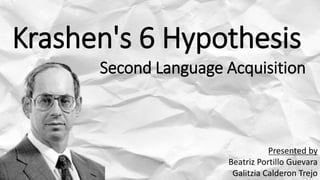
Krashen's 6 hyphotesis
- 1. Krashen's 6 Hypothesis Second Language Acquisition Presented by Beatriz Portillo Guevara Galitzia Calderon Trejo
- 2. •Objective: Let’s describe The 6 Krashen’s Hypothesis by using a power point presentation, to have a discussion with the class, to find out the benefits of taking this knowledge into consideration when teaching.
- 3. •About 25 years ago, a psychologist named Stephen Krashen transformed language teaching. He had been developing his ideas over a number of years, but several books he published in the 1980s received widespread acceptance.
- 4. “Language acquisition occurs when language is used for what it was designed for, communication.” Stephen Krashen
- 5. Comprises of six main hypotheses: 1.Acquisition-Learning hypothesis 2.Monitor hypothesis 3.Natural Order hypothesis 4.Input hypothesis 5.Affective Filter hypothesis 6.The Reading Hypothesis Second Language Acquisition Theory
- 6. The acquisition-learning hypothesis The “acquired system” and The “learned system”
- 7. What is the difference between LEARNING a language and ADQUIRING a language?
- 8. Acquisition Learning • Subconscious process • Meaningful interaction • Communicative act • Product of subconscious • Depends on attitude • Conscious process • Formal instruction • Grammar • Product of formal learning • Depends on aptitude
- 9. Krashen’s Hypotheses: 1. The acquisition-learning hypothesis. There is a difference between learning, which is purposeful and conscious, and acquisition which is natural and subconscious. (Markee 1997, pp. 25–26)
- 10. There are five different stages in the second language acquisition process: 1. The Silent Period 2. The Early Production Period 3. The Speech Emergence Period 4. The Intermediate Production Period 5. The Advanced Production Period
- 11. Application for Teaching • According to this theory, the optimal way a language is learned is through natural communication.
- 12. • As a second language teacher, the ideal is to create a situation wherein language is used in order to fulfill authentic purposes. This is turn, will help students to ‘acquire’ the language instead of just ‘learning’ it.
- 13. Krashen’s hypotheses: 2. The monitor hypothesis. This hypothesis states that conscious learning functions only as a monitor to edit and correct the output of the acquired language. (Markee 1997, pp. 25–26)
- 14. Use learned language to self- correct what is acquired.
- 15. Application for Teaching •As an SL teacher it will always be a challenge to strike a balance between encouraging accuracy and fluency in your students.
- 16. This balance will depend on numerous variables including: •The language level of the students •The context of language use •The personal goals of each student.
- 17. What is Communicative Competency? •Communicative competency is the correlation between fluency and accuracy.
- 18. “Language is best taught when it is being used to transmit messages, not when it is explicitly taught for conscious learning.” (Krashen and Terrell, 1995)
- 19. Krashen’s hypotheses: 3. The natural order hypothesis. This hypothesis states that grammatical structures are acquired in a predictable order just the same way that the native speaker learned their native language. (Markee 1997, pp. 25–26)
- 20. Step by step Predictable order She is walking instead of She walked
- 21. •The acquisition of grammatical structures follows a “natural order” which is predictable. •English is perhaps the most studied language as far as natural order hypothesis is concerned, and of all structures of English, morphology is the most studied.
- 22. Application for Teaching •This hypothesis highlights the importance of using the Target Language in the classroom. The goal of any language program is for learners to be able to communicate effectively.
- 23. •By providing as much comprehensible input as possible, especially in situations when learners are not exposed to the TL outside of the classroom, the teacher is able to create a more effective opportunity for language acquisition.
- 24. Krashen’s hypotheses: 4. The input hypothesis. The Input Hypothesis states that students acquire language when they need to understand input that is slightly beyond their level of competence. “Krashen refers to this by the formula L +1 (where L+1 is the stage immediately following L along some natural order.)” (Markee 1997, pp. 25–26)
- 25. Application for Teaching •According to this hypothesis, teachers should be aware that certain structures of a language are easier to acquire than others and therefore language structures should be taught in an order that is conductive to learning.
- 26. •Teachers should start by introducing language concepts that are relatively easy for learners to acquire and then use scaffolding to introduce more difficult concepts.
- 27. Krashen’s hypotheses: 5. The affective filter hypothesis. This hypothesis states that emotional factors can block or affect the process of acquisition. (Markee 1997, pp. 25–26)
- 28. The main emotional attitude factors of motivation, self- confidence, and anxiety can impede language acquisition.
- 29. A students with high affective filter are less likely to learn. The teacher should promote a low anxiety, low stress environment.
- 30. •According to Krashen we acquire a language when we are given comprehensible input in low-anxiety situations and when we are presented with interesting and meaningful messages that we actually understand.
- 31. Application for Teaching •In any aspect of education it is always important to create a safe, welcoming environment in which students can learn. In language education this may be especially important since in order to take in and produce language, learners need to feel that they are able to make mistakes and take risks. This relates to directly to Krashen’s hypothesis of the affective filter.
- 32. Krashen’s hypotheses: 6. The Reading Hypothesis. This hypothesis states that the more we read in a SL the greater our vocabulary.
- 33. Application for Teaching It is important to involve reading in the language classroom to increase knowledge of the language and the way it is used in real-life contexts.
